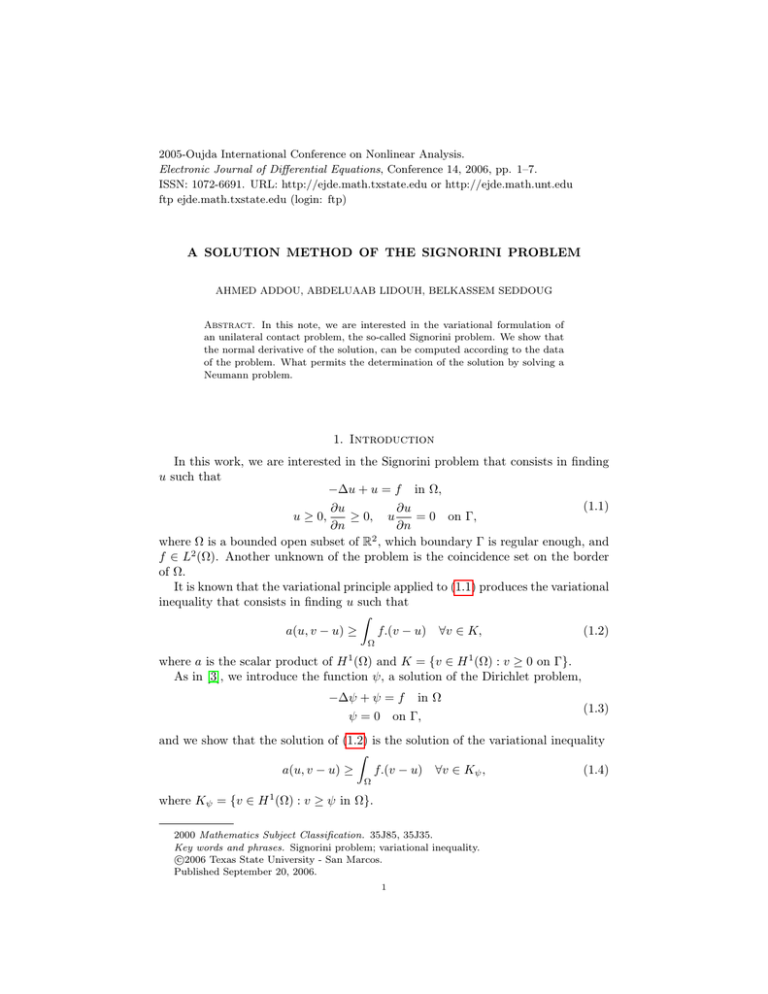2005-Oujda International Conference on Nonlinear Analysis.
advertisement

2005-Oujda International Conference on Nonlinear Analysis.
Electronic Journal of Differential Equations, Conference 14, 2006, pp. 1–7.
ISSN: 1072-6691. URL: http://ejde.math.txstate.edu or http://ejde.math.unt.edu
ftp ejde.math.txstate.edu (login: ftp)
A SOLUTION METHOD OF THE SIGNORINI PROBLEM
AHMED ADDOU, ABDELUAAB LIDOUH, BELKASSEM SEDDOUG
Abstract. In this note, we are interested in the variational formulation of
an unilateral contact problem, the so-called Signorini problem. We show that
the normal derivative of the solution, can be computed according to the data
of the problem. What permits the determination of the solution by solving a
Neumann problem.
1. Introduction
In this work, we are interested in the Signorini problem that consists in finding
u such that
−∆u + u = f in Ω,
(1.1)
∂u
∂u
u ≥ 0,
≥ 0, u
= 0 on Γ,
∂n
∂n
where Ω is a bounded open subset of R2 , which boundary Γ is regular enough, and
f ∈ L2 (Ω). Another unknown of the problem is the coincidence set on the border
of Ω.
It is known that the variational principle applied to (1.1) produces the variational
inequality that consists in finding u such that
Z
a(u, v − u) ≥
f.(v − u) ∀v ∈ K,
(1.2)
Ω
1
where a is the scalar product of H (Ω) and K = {v ∈ H 1 (Ω) : v ≥ 0 on Γ}.
As in [3], we introduce the function ψ, a solution of the Dirichlet problem,
−∆ψ + ψ = f
in Ω
ψ = 0 on Γ,
(1.3)
and we show that the solution of (1.2) is the solution of the variational inequality
Z
a(u, v − u) ≥
f.(v − u) ∀v ∈ Kψ ,
(1.4)
Ω
1
where Kψ = {v ∈ H (Ω) : v ≥ ψ in Ω}.
2000 Mathematics Subject Classification. 35J85, 35J35.
Key words and phrases. Signorini problem; variational inequality.
c
2006
Texas State University - San Marcos.
Published September 20, 2006.
1
2
A. ADDOU, A. LIDOUH, B. SEDDOUG
EJDE/CONF/14
To solve problem (1.4), we propose a method that consists in determining first
with the help of the data of the problem, then solving a Neumann problem to
determine u.
∂u
∂n ,
2. Formulation of the problem
Let Ω be a bounded open subset of R2 , with boundary Γ is regular enough. The
Sobolev space H 1 (Ω) is equipped with its scalar product
Z
Z
a(u, v) =
∇u.∇vdx +
u.vdx ∀u, v ∈ H 1 (Ω).
Ω
Ω
We denote by K the closed convex cone of H 1 (Ω) defined as
K = {v ∈ H 1 (Ω) : v ≥ 0 on Γ}.
Then we consider the variational inequality problem: Find u ∈ K such that
Z
a(u, v − u) ≥
f.(v − u), ∀v ∈ K,
(2.1)
Ω
2
where f ∈ L (Ω).
In the sequel, we use of the following notations:
v + = max(v, 0),
v − = min(v, 0)
such that v = v + + v − for all v in L2 (Ω) or in L2 (Γ).
We will note indifferently a function v of H 1 (Ω) and its restriction to Γ.
Proposition 2.1. Problem (2.1) is equivalent to the problem: Find u ∈ Kψ such
that
Z
a(u, v − u) ≥
f.(v − u), ∀v ∈ Kψ ,
(2.2)
Ω
where ψ is given by (1.3) and Kψ = {v ∈ H 1 (Ω) : v ≥ ψ in Ω}.
Proof. It suffices to show that the solution u of (2.1) is in Kψ , i.e: u ≥ ψ.
Let u be the solution of (2.1). With v = u − (u − ψ)− ∈ K in (2.1), and while
taking account of (1.3), one has
a((u − ψ)− , (u − ψ)− ) ≤ 0.
So (u − ψ)− = 0, which implies u ≥ ψ in Ω.
Using Green’s formula, (2.1) can be written as: Find u ∈ Kψ such that
a(u − ψ, v − u) + h
∂ψ
, v − ui ≥ 0,
∂n
∀v ∈ Kψ ,
(2.3)
where h., .i designates the scalar product of L2 (Γ), and ∂ψ
∂n the normal derivative of
ψ.
To have ∂ψ
∂n at the same time as ψ, we propose the resolution of (1.3) by enforcing
the boundary condition with Lagrange multipliers (see [4]), then the variational
1
formulation of (1.3) reads: Find (ψ, λ) ∈ H 1 (Ω) × H − 2 (Γ) such that
Z
Z
a(ψ, v) − λv =
f v, ∀v ∈ H 1 (Ω),
Γ
Ω
Z
(2.4)
− 21
µψ = 0, ∀µ ∈ H (Γ),
Γ
EJDE/CONF/14
A SOLUTION METHOD
3
R
1
Rwhose solution is the saddle point of the Lagrangian J (v, µ) = 2 a(v, v) − Ω f v −
µv.
Γ
It is known (see [4]) that problem (2.4) has a unique solution (ψ, λ), verifying
−∆ψ + ψ = f
in Ω,
∂ψ
λ=
on Γ,
∂n
ψ = 0 on Γ.
(2.5)
Note that f being in L2 (Ω), implies ψ in H 2 (Ω) which implies
∂ψ
∂n
in H 1/2 (Γ).
3. Transformation of the problem
Hereafter we deal with the problem (2.3), and we consider the function ϕ :
L2 (Γ) → R defined as
∂ψ + +
ν 7→ h
, ν i.
∂n
Note that ϕ is convex and continuous on L2 (Γ).
Proposition 3.1. A function u is a solution of (2.3) if and only if w = u − ψ is
the solution of the problem: Find w ∈ H 1 (Ω) such that
a(w, v − w) + ϕ(v) − ϕ(w) + h
∂ψ −
, v − wi ≥ 0,
∂n
∀v ∈ H 1 (Ω).
(3.1)
Proof. Since the two problems (2.3) and (3.1) have an unique solution, it suffices
to show that the solution w of (3.1) is non negative in Ω. Let w be the solution of
(3.1), with v = w+ in (3.1), we have
a(w, −w− ) + h(
then a(w− , w− ) ≤ h
∂ψ −
, −w− i
∂n
∂ψ −
) , −w− i ≥ 0
∂n
≤ 0, so w− = 0.
We remark that problem (3.1) differs from (2.3) by the fact that it is without
constraints.
Proposition 3.2. A function w is solution of problem (3.1) if and only if (w, µ)
is solution of the problem: Find (w, µ) ∈ H 1 (Ω) × L2 (Γ) such that
∂ψ −
) , vi = 0
∂n
µ ∈ ∂ϕ(w),
a(w, v) + hµ, vi + h(
∀v ∈ H 1 (Ω),
(3.2)
where ∂ϕ(w) = {λ ∈ L2 (Γ) : ∀ν ∈ L2 (Γ), hλ, ν − wi ≤ ϕ(ν) − ϕ(w)} designates the
subdifferential of ϕ at w.
Proof. Let w be the solution of (3.1). On the one hand, for all v in H01 (Ω), we have
a(w, v) = 0, hence the mapping
v 7→ a(w, v) + h(
is well defined on Γ.
∂ψ −
) , vi
∂n
4
A. ADDOU, A. LIDOUH, B. SEDDOUG
EJDE/CONF/14
On the other hand, for all v in H 1 (Ω), one has
∂ψ −
a(w, v) + h
, vi ≥ ϕ(w) − ϕ(v + w)
∂n
∂ψ + +
≥h
, w − (v + w)+ i
∂n
∂ψ + +
≥ −h
,v i
∂n
∂ψ + 2 kv|Γ kL2 (Γ) .
≥ −
L (Γ)
∂n
Using the same argument, and with −v one has
∂ψ + ∂ψ −
2 kv|Γ kL2 (Γ) .
a(w, −v) + h(
) , −vi ≥ −
L (Γ)
∂n
∂n
Hence for all v in H 1 (Ω), we have
|a(w, v) + h(
∂ψ +
∂ψ −
) , vi| ≤ k(
) kL2 (Γ) kv|Γ kL2 (Γ) .
∂n
∂n
−
1/2
Therefore, the linear form v 7→ a(w, v) + h( ∂ψ
(Γ) for
∂n ) , vi is continuous on H
2
1/2
2
the norm of L (Γ). Then because of the density of H (Γ) in L (Γ), there exists
µ in L2 (Γ) verifying the equality of (3.2).
Inversely, it is easy to see that if (w, µ) is solution of (3.2) then w is solution of
(3.1).
To characterize ∂ϕ(w), we consider the closed convex set of L2 (Γ):
C = {λ ∈ L2 (Γ) : ∀ν ∈ L2 (Γ) : hλ, νi ≤ ϕ(ν)}.
+
It is easy to show that C = {λ ∈ L2 (Γ) : 0 ≤ λ ≤ ( ∂ψ
∂n ) a.e in Γ}.
Lemma 3.3. for all µ in L2 (Γ) and w in H 1 (Ω), one has µ ∈ ∂ϕ(w) if and only if
µ∈C
In particular
+
( ∂ψ
∂n ) .χ[w|Γ >0]
and
hλ − µ, wi ≤ 0,
∀λ ∈ C.
∈ ∂ϕ(w).
Proof. Let µ ∈ ∂ϕ(w), i.e,
∀v ∈ H 1 (Ω),
hµ, v − wi ≤ ϕ(v) − ϕ(w).
(3.3)
With v = 2w and v = 0 in (3.3), and while ϕ is positively homogeneous, one has
hµ, wi = ϕ(w).
Therefore, while taking back (3.3), one deducts that µ ∈ C. Inversely, let µ ∈ C
and hλ − µ, wi ≤ 0, for all λ ∈ C. For λ in ∂ϕ(w) ⊂ C, we have
hλ, wi = ϕ(w) and hλ − µ, wi = 0.
1
So that for all v ∈ H (Ω), hµ, v − wi = hµ, vi − ϕ(w) ≤ ϕ(v) − ϕ(w).
Taking into account lemma 3.3, the problem (3.2) can be written as: Find
(w, µ) ∈ H 1 (Ω) × C such that
∂ψ −
) , vi = 0 ∀v ∈ H 1 (Ω),
∂n
hλ − µ, wi ≤ 0, ∀λ ∈ C.
a(w, v) + hµ, vi + h(
(3.4)
EJDE/CONF/14
A SOLUTION METHOD
5
Remark 3.4. The bilinear form a is symmetric, then the problem (3.4) is equivalent
to the saddle point problem [2]: Find (w, µ) ∈ H 1 (Ω) × C such that
∀(v, λ) ∈ H 1 (Ω) × C,
L(w, λ) ≤ L(w, µ) ≤ L(v, µ) = 0
where the Lagrangian L is defined on H 1 (Ω) × L2 (Γ) by
1
∂ψ −
a(v, v) + hλ, vi + h(
) , vi
2
∂n
The study of the mixed formulation (3.4), is in preparation by the authors.
However, it is clear that the determination, a priori, of µ, permits to solve the
problem (3.4) as being the Neumann problem
L(v, λ) =
−∆w + w = 0 in Ω,
∂ψ −
∂w
= −µ − (
)
∂n
∂n
Which defines u as a solution of the problem
−∆u + u = f
on Γ.
in Ω,
∂ψ +
∂u
=(
) −µ
∂n
∂n
on Γ,
What we propose in this work is to uncouple the problem (3.4), by showing that
µ can be computed according to the data of the initial problem. We consider, then,
1
the linear mapping A : H − 2 (Γ) → H 1 (Ω) defined by g 7→ v, where v is a solution
to
−∆v + v = 0 in Ω,
∂v
= g on Γ,
∂n
which is continuous, more precisely, one has the following result [4, theorem 2.7].
Lemma 3.5. There exist two positive constants c1 and c2 , such that
c1 kAgkH 1 (Ω) ≤ kgk
1
H − 2 (Γ)
≤ c2 kAgkH 1 (Ω) ,
for all g in H −1/2 (Γ).
∂v
Using the set M = A(C) = {v ∈ H 1 (Ω) : −∆v + v = 0 in Ω and ∂n
∈ C} which
1
is closed, bounded and convex in H (Ω), problem (3.4), can be written as: Find
(w, z) ∈ H 1 (Ω) × M such that
a(w + z + t, v) = 0
∀v ∈ H 1 (Ω),
a(s − z, w) ≤ 0, ∀s ∈ M,
−
where t = A ( ∂ψ
and z = Aµ. What defines z as being the projection of −t on
∂n )
M ; i.e,
∂ψ − t=A (
) , z = proj M (−t) and w = −z − t.
∂n
4. A projection algorithm
For the determination of z = projM (−t), and therefore µ, according to the data,
we propose a projection algorithm inspired of the one of Degueil [1].
6
A. ADDOU, A. LIDOUH, B. SEDDOUG
EJDE/CONF/14
Description of the algorithm. For an initial guess µ0 ∈ C (for example µ0 = 0),
we compute z0 such that z0 = Aµ0 then we construct the sequences (µn ) and (zn ),
as follows:
(1) Given zn and µn such that zn = Aµn and µn ∈ C, we compute vn = Agn
where
∂ψ +
gn = (
) .χ[(−t−zn )|Γ >0] .
∂n
By lemma 3.3, we see that gn ∈ ∂ϕ(−t − zn ) ⊂ C, and then:
a(v − vn , zn + t) ≥ 0, ∀v ∈ M.
(4.1)
(2) We compute zn+1 = proj[zn ,vn ] (−t) (the projection of −t on the segment
[zn , vn ]), i.e,
zn+1 = λn vn + (1 − λn )zn ,
µn+1 = λn gn + (1 − λn )µn
hµn − gn , zn + ti a(zn − vn , zn + t)
=
λn = min 1,
kvn − zn k2H 1 (Ω)
hµn − gn , vn − zn i
(4.2)
if vn = zn then zn+1 = zn , the algorithm stops.
Convergence result. As in [1], we have the following convergence result.
Theorem 4.1. With the hypothesis and notation above, one has
lim kzn − zkH 1 (Ω) = lim kµn − µk
n→+∞
1
H − 2 (Γ)
n→+∞
= 0.
Proof. Let us, first, show that limn→+∞ kzn − zkH 1 (Ω) = 0. For all n, one has:
kzn + tk2H 1 (Ω) = kzn − zn+1 k2H 1 (Ω) + kzn+1 + tk2H 1 (Ω) + 2a(zn − zn+1 , zn+1 + t)
≥ kzn − zn+1 k2H 1 (Ω) + kzn+1 + tk2H 1 (Ω)
Then kzn − zn+1 k2H 1 (Ω) ≤ kzn + tk2H 1 (Ω) − kzn+1 + tk2H 1 (Ω) , what implies that
lim kzn − zn+1 kH 1 (Ω) = 0.
n→+∞
(4.3)
On the other hand, z = projM (−t), then
a(v − z, z + t) ≥ 0,
∀v ∈ M.
(4.4)
With v = zn+1 in (4.4) and while taking account of ((4.1) and (4.2)), one has
kzn+1 − zk2H 1 (Ω)
= a(zn+1 − z, zn+1 − zn ) + a(zn+1 − z, zn + t) − a(zn+1 − z, z + t)
≤ a(zn+1 − z, zn+1 − zn ) + a(zn+1 − z, zn + t)
≤ a(zn+1 − z, zn+1 − zn ) + a(zn+1 − z, zn + t) + a(z − vn , zn + t)
≤ a(zn+1 − z, zn+1 − zn ) + a(zn+1 − vn , zn + t)
≤ a(zn+1 − z, zn+1 − zn ) + (1 − λn )a(zn − vn , zn + t)
≤ a(zn+1 − z, zn+1 − zn ) + (1 − λn )λn kzn − vn k2H 1 (Ω)
≤ a(zn+1 − z, zn+1 − zn ) + (1 − λn )kzn+1 − zn kH 1 (Ω) kzn − vn kH 1 (Ω)
≤ kzn+1 − zn kH 1 (Ω) kzn+1 − zkH 1 (Ω) + kzn − vn kH 1 (Ω) .
µk
We conclude using (4.3) and the fact that M is bounded. To show that limn→+∞ kµn −
= 0, it suffices to use Lemma 3.5.
−1
2
H
(Γ)
EJDE/CONF/14
A SOLUTION METHOD
7
References
[1] A. Degueil. Résolution par une méthode d’él éments finis d’un problème de STEPHAN en
terme de température et en teneur en matériau non gelé. Thèse 3ème cycle, Bordeaux,1977.
[2] I. Ekeland, R. Temam. Analyse convexe et problèmes variationnels. Dunod, Paris 1974.
[3] D. Kinderleher, G. Stampacchia. An introduction to variational inequalities and their applications. Academic Press (1980).
[4] I. Babuska. The finite element method with Lagrangian multipliers. Numerische Mathematik
20, pp. 179-192, 1973.
Ahmed Addou
Université Mohammed premier, Faculté des sciences, Oujda, Maroc
E-mail address: addou@sciences.univ-oujda.ac.ma
Abdeluaab Lidouh
Université Mohammed premier, Faculté des sciences, Oujda, Maroc
E-mail address: lidouh@sciences.univ-oujda.ac.ma
Belkassem Seddoug
Université Mohammed premier, Faculté des sciences, Oujda, Maroc
E-mail address: seddougbelkassem@yahoo.fr






